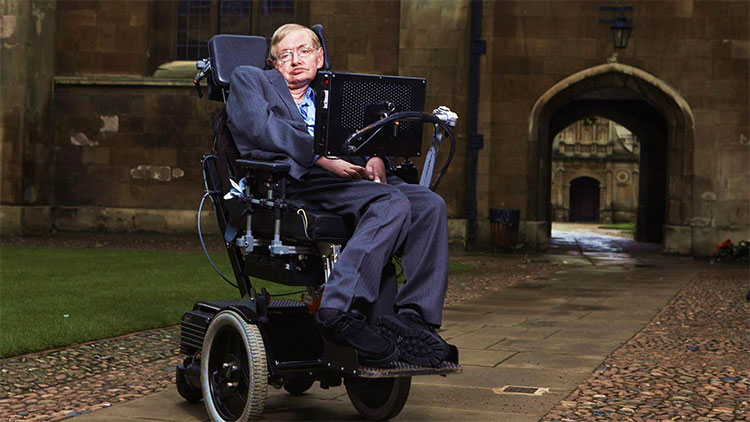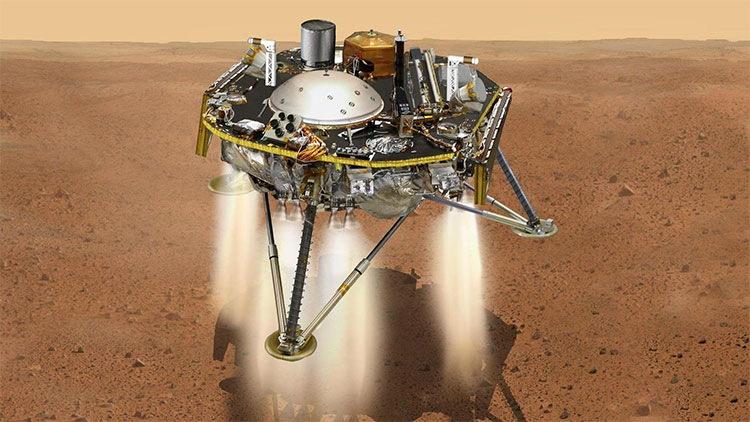10 outstanding scientific events in the world in 2018
Professor Stephen Hawking died, the NASA probe landed on Mars, changing the definition of the kilogram . the memorable milestones of the past year.

Professor Stephen Hawking sits on a wheelchair and the biggest goal is to fully understand the universe.(Photo: Evolution News).
The theoretical physicist and cosmologist Stephen Hawking has suffered from unilateral muscular atrophy since he was 23 years old. The disease destroys the neuronal system causing his body to be paralyzed. The doctor predicted that he could only live for two more years, but Hawking lived for more than 50 years.
"Under the cloud of the threat of death, I was surprised to find that I enjoy life longer than before. I started to make progress in my research," Hawking said.
He became a professor of physics at the age of 35, laying the foundations for cosmology with the hypothesis that the black hole emitted "Hawking radiation" in 1974. The 1988 Brief History of the Year by him was more authoritative. 10 million copies sold.
Stephen Hawking died at his home in Cambridge (England), on March 14, 2018, aged 76. The way he overcame illness and reached the pinnacle of research has inspired those who do science.

The InSight probe "lands" successfully on the surface of Mars.(Photo: Space News).
On November 27, NASA's $ 850 million InSight probe landed safely on Mars, marking the first successful landing on the red planet. The landing is described as "horrifying 7 minutes" because InSight must slow down from 19,800 km / h to 5 km / h in just a few minutes.
InSight successfully landed a new era with subsequent discoveries so scientists could know what was beneath the surface of Mars, which was always a mystery.
The robotic arm on InSight will begin moving seismic gauges and drillers out to probe earthquakes on the Martian surface and drill down to a depth of nearly 4.9 meters above the surface, then measure temperature here.

The vertical landing car is being used by Dubai police to practice.(Photo: CNN).
2018 recorded many models of aircraft introduced and tested, which were previously available only in sci-fi movies.
The ultra-light flying car controlled by Flyer steering wheel was launched by Kitty Hawk in the US in 6/2018 with 10 propellers and batteries to fly for 20 minutes. The model can fly three meters high with a maximum speed of 32 km / h.
Terrafugia company is also producing Transition flying cars in the US. Two-seater electric and gasoline vehicles can switch between driving and flying modes in less than a minute. Transition can fly 640 km, maximum speed 160 km / h.
Scorpion, Hoversurf's world's first personal flying car, was launched in late October. The vertical take-off vehicle combines the design of unmanned aircraft and 4-wheel motorcycles in sight. Watch Dubai practice. Scorpion can fly at 5 meters, the maximum speed is 96 km / h.
Flying vehicles are promising prospects of ending traffic jams in the future.
On August 12, NASA successfully launched the Parker probe at Cape Canaveral Air Force Station, Florida, USA. The ship has the task of approaching the Sun at the closest distance ever in the 7-year project.
As planned, the Parker Solar will fly 24 rounds of the Sun and borrow Venus's gravity to narrow its trajectory. The ship will approach the Sun most in 2024 at a distance of 6.2 million km and become the first spacecraft to fly over the Sun's corona.
The successful launch of the Parker ship offers hope for scientists to discover the coronary ring, solar wind, the principle of how stars work, the forecast of cosmic weather events that may affect satellites, astronauts and life on Earth.

Researcher Ha Kien Khue.(Photo: AP).
On November 26, in Hong Kong, researcher Xia Jianue (from Shenzhen, China) announced the creation of the first two twin-girl correction girls in the world with the technique of editing CRISPR-Cas9 gene on embryo of 7 couples.
Mr. Ha said that the experiment is not to treat or prevent genetic diseases, but to try to insert biological features that are rarely resistant to HIV infection.
Prof. Ha Kien Khue's work exploded a global controversy over the application of gene technology on humans, especially genetic modification, with religious, moral and legal concerns. On the other hand, researchers believe that genetic modification in humans without verifying the interaction of additional or removed genes is risky.
No one has confirmed this is a long evolutionary step or a human disaster.

Two healthy long-tailed monkeys named Zhong Zhong and Hua Hua.(Photo: NPR).
The team at the Academy of Sciences in Shanghai for the first time successfully replicated monkeys with somatic cell nuclear transfer (SCNT). To create two healthy long-tailed monkeys named Zhong Zhong and Hua Hua, they took the nucleus from an individual's oocyte and replaced it with a somatic stem cell from another individual. After regenerating eggs are transplanted into a pregnant pregnancy and develop into a copy of the cell donor.
This method of cloning is very difficult to do in monkeys. The secret to the success of researchers is to conduct the SCNT process as quickly as possible to limit the damage to eggs.
The creation of cloned monkeys with identical genes will help create a source of specimens to study genetic diseases of the brain, cancer, immune or metabolic disorders, allowing assessment of effectiveness. of medicines before being put into clinical use.

Prototype international kilogram in safe cellar in Paris.(Photo: Independent).
From May 20, 2019, the definition of kilogram changes with Planck's constant to ensure that this quantity is always reliable, making mass measurements accurate. Previously the kilogram unit was originally determined by the Le Grand K (IPK) international kilogram prototype, a cylindrical metal block in a safe tunnel in Paris 130 years ago.
IPK is a standard kilogram but scientists have long known that its mass changes over time due to wear and air pollution on the surface. The change is small but can affect industries that need high precision.
Therefore, on November 16, representatives from more than 60 countries met in France and agreed to redefine the kilogram with the Planck constant associated with the quantum industry. This constant is measured using the "Kibble equalizer" engine developed by the late physicist Bryan Kibble.
On December 13, VSS Unity, Virgin Galactic's rocket-powered supersonic aircraft, launched to the edge of the universe from California's Mojave Airport and Space Station.
VSS Unity separated from the mother ship WhiteKnightTwo at an altitude of 13,106 m, activated the rocket engine for 60 seconds and flew straight up at nearly three times the speed of sound. The aircraft took the two former pilots to a maximum height of 82.7 km, exceeding the milestone landmark of 80.5 km.
This test shows the ability to transport people to the edge of VSS Unity's secure universe, helping Virgin Galactic move closer to its goal of bringing visitors into space. "For the first time in history, a manned spacecraft was built to carry private passengers to space," said Richard Branson, founder of Virgin Galactic.
55 km long sea bridge connecting Hong Kong - Macau - Chu Hai inaugurated on October 23 was named the world architectural wonder. With an investment of US $ 18 billion, this is the world's longest and longest sea crossing bridge on Earth. The work reduces the travel time from Hong Kong to Zhuhai City from three hours to 30 minutes, opening up great potential for economic development and tourism.
The bridge was highly appreciated for construction techniques, because engineers had to overcome the biggest challenge when building a 6.7 km tunnel under the sea. The tunnel runs between two artificial islands, so the construction team must create a frame structure by using 120 steel hollow pillars, each 55 m high and weighing 50 tons, close to the world's largest passenger aircraft, Airbus 380 .
Steel used to build bridges more than 60 times the Eiffel Tower. The bridge withstands 8-magnitude earthquakes, super storms and boats collide.
The longest total eclipse of the century takes place in the morning of July 28, extending from 0h14 to 5h19 in Hanoi time. This is one of the most eye-catching astronomical events in the 21st century. The phenomenon can be observed in most countries in Africa, Asia, Europe and Oceania.
True moon is a phenomenon that occurs when the Moon is in a position to align with the Earth and the Sun, in which the Earth lies in the middle, obscuring the sunlight and casting shadows on its natural satellite. The total eclipse is when the Moon is completely in the shadow of the Earth.
- 10 outstanding science and technology events 2014
- Looking back at the outstanding scientific events in 2015
- 10 most outstanding scientific events in 2016
- 10 typical scientific and health events in 2005
- Ten outstanding natural resources industry events
- 10 outstanding Vietnamese environmental events in 2011
- 10 outstanding events in 2005 of VNPT
- 10 Vietnamese science and technology events in 2008
- Famous mystical events in history
- 10 outstanding scientific and technological events in 2005
- 10 scientific breakthroughs in 2005
- Chu Van An Teacher became the fourth Vietnamese celebrity to be honored by UNESCO
 Vietnam 5th Asian champion on fuel-efficient vehicles
Vietnam 5th Asian champion on fuel-efficient vehicles We can read all NASA studies completely free of charge
We can read all NASA studies completely free of charge Singer and songwriter Bob Dylan won the 2016 Nobel Prize for Literature
Singer and songwriter Bob Dylan won the 2016 Nobel Prize for Literature Scientific revolution in Asia
Scientific revolution in Asia